
BLOG ..BLOGUE
News from SouthWest ..Des nouvelles du Sud-Ouest
A Voice From the Second World War
I had thought to hold this material back until Remembrance Day, but recent events in Ukraine made me decide to share it now.
A few weeks ago, I shared some photos and stories about Harold Morrow, who sang at Verdun United and directed several of the YAG revues in the 50s and 60s. Along with several photos and reminiscences, Eileen - Harold’s daughter - also shared the letter below which predates her birth. It was written by the Rev. J.G. Joyce to Harold when he (Harold) was stationed in Italy during World War II. At my urging, Eileen also shared some photos of her father from that time.
“Like many veterans of that war and others,” Eileen says, “Dad rarely spoke of his time in service. Mom always said that he returned a changed man, suffering from many nightmares and the lasting effects of malaria. But with the loving support of Mom, his close friends, his church, and his love of music, in time he was able to overcome his demons.”
I think you will agree that Rev. Joyce had a way with words. Blending news from the homefront and commentary on world events, the letter is a snapshot of a moment in time: a time of turmoil and insecurity; a time of wins and devastating losses; a time of sacrifice and of hope for a brighter future.
I hope you will enjoy reading it as much as I did.
Amy
[This is my transcription, with a little help from Eileen. You can see pictures of the original letter below.]
November 23, 1944
Dear Harold,
Your mother the night before last in the church hall was telling me you keep well and are still in Italy. I hope your attack of malaria did not leave any ill effects. From what we are told conditions in Italy are anything but what we would expect from a country so historic, and the seat of the Catholic church. From reports we learn that conditions there parallel the conditions in Quebec, big religious institutions and churches, and most of the people destitute and subservient. However there seems to be a tremendous political surge there now, and with the Communists strong, and the equally strong socialists working together Italy may not only get away from Fascism but much of her superstition.
This morning we have a little snow on the ground but it is disappearing rapidly under the impact of traffic and mild temperature. Sidney Long and J. Hudson are putting on a choir concert tomorrow night. We have senior, Intermediate and junior choirs taking part, the program has taken much time, and the decorations on the stage are new and bright. Our Senior choir usually on Sundays has one bass and one tenor. Hope you will soon be back to give us the helpfulness of your rich bass voice. Your sister Ann sings in the treble side.
Well, I don’t think Hitler can stand much longer. The Allies are striking hard in the West and the Russians in the East. Ottawa, or the McKenzie King Gov’t is passing through a crisis – whether to introduce conscription and compel the French to go or allow the volunteer system to take care of reinforcements so as to please the French. Much serious trouble can develop, or the whole matter might fizzle out with the French sentiment prevailing.
We surely wish you the best kind of Christmas and a New Year with Victory. Next year we hope you and your dear wife will be with us to enjoy the blessings which come with peace. All the choir and congregation join in these wishes to you.
Cordially yours,
J.G. Joyce
You can read more about Rev. Joyce in this Blog post.
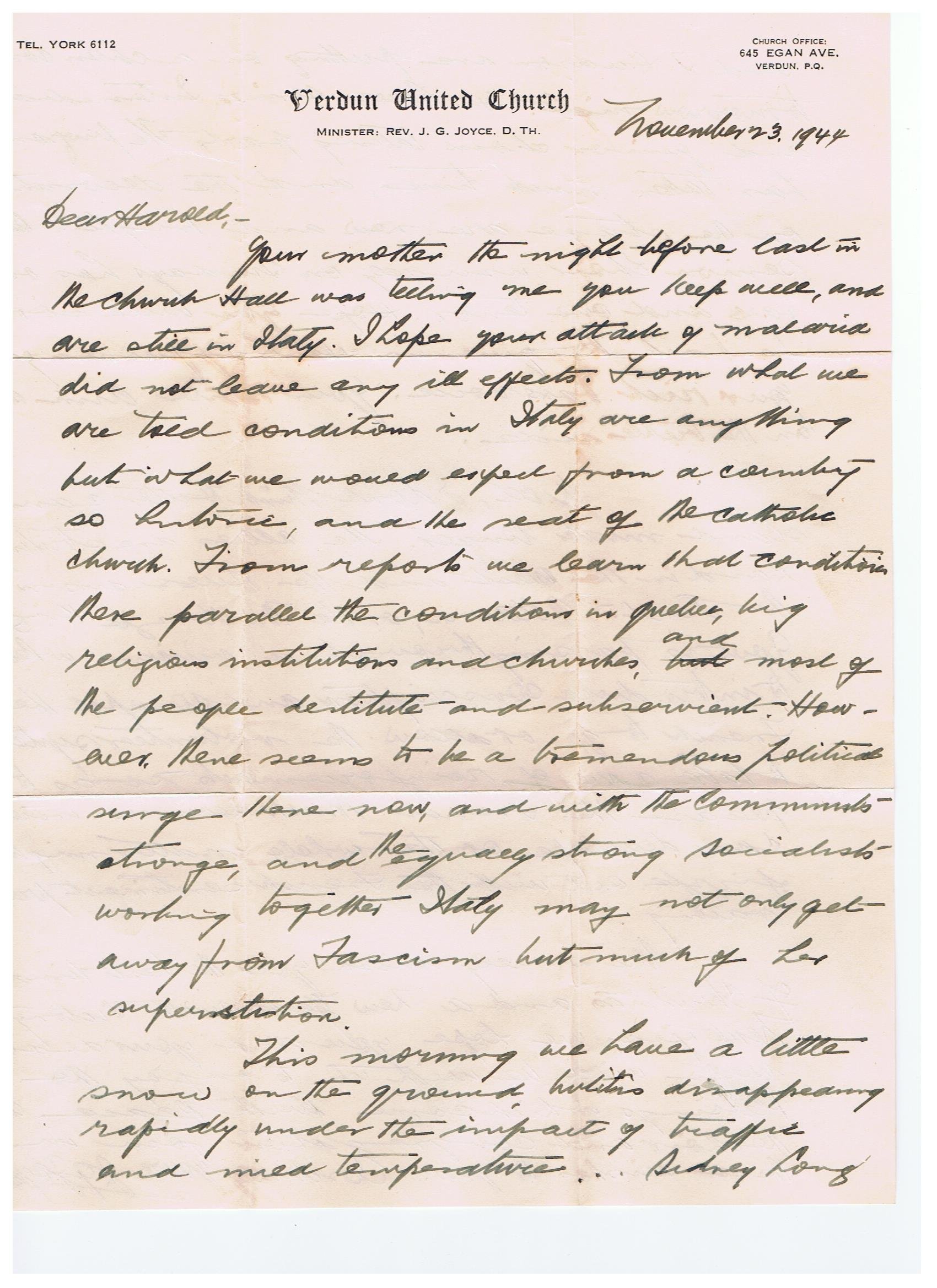




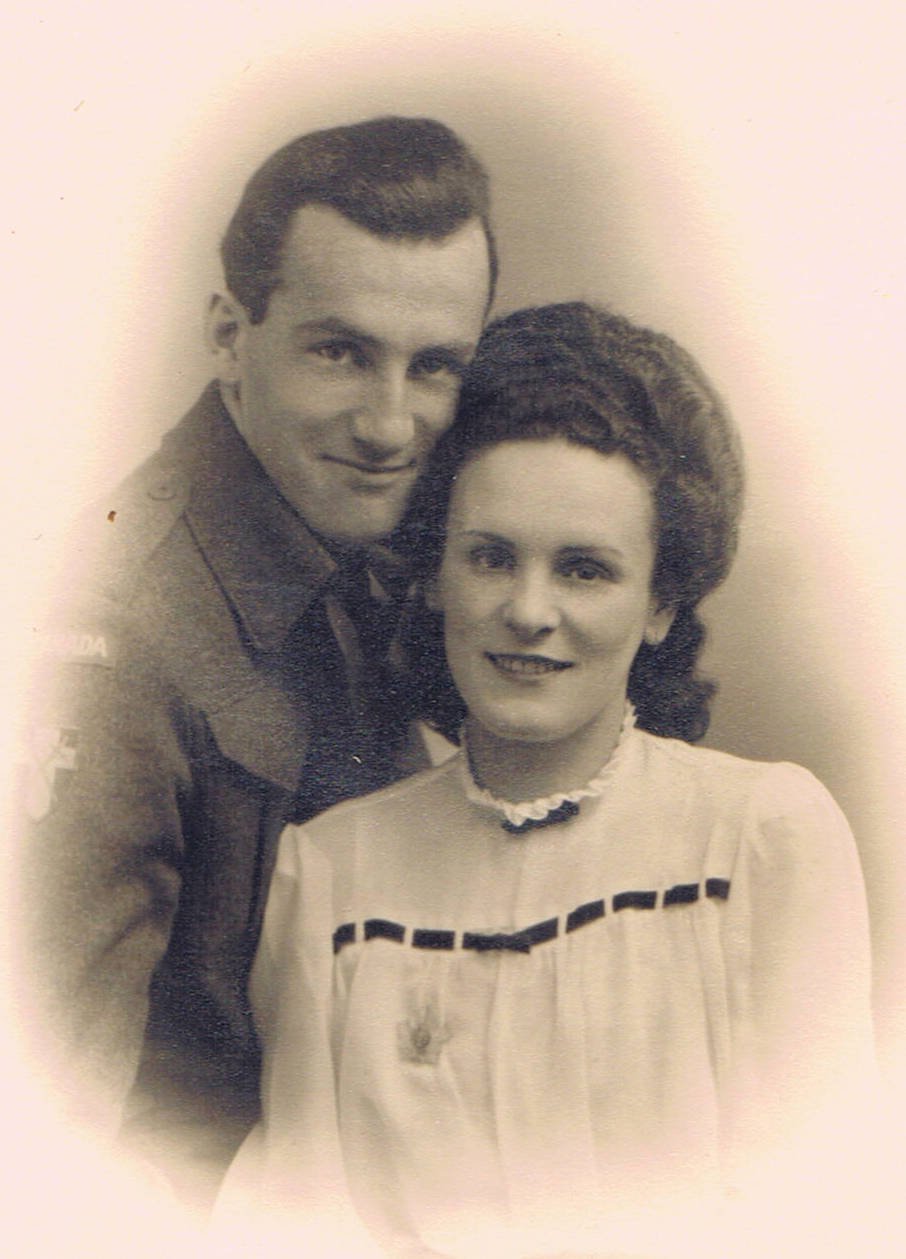
Banner image: Trooper Harold Morrow’s unit, Three Rivers Regiment - Tank Corps taken in Sicily.
Esther Howland: Mother of the American Valentine
By Ray Cavanagh, TIME magazine, February 10, 2017
For the artistry of her designs and her success at commercializing Valentine’s Day cards in the U.S., Esther Howland became known as the “Mother of the American Valentine.” Her distinctive cards are cherished by collectors to this day.
Howland did not invent the Valentine’s Day card — handmade versions had been circulating in Europe since at least the 15th century, and by the early 19th century, the U.K. was producing significant numbers of commercial valentines. In that period, however, American valentines frequently were comic rather than romantic. Often ethnically pejorative and personally insulting, these types of cards — many of them sent anonymously and with malice — were far removed from the sort of sentiment Esther Howland had in mind.
Born in 1828 in Worcester, Mass., she entered a family of comfortable means, as her father, Southworth Howland, owned a successful stationery business thatproduced such items as textbooks and engraved cards. She attended nearby Mount Holyoke College (then known as the Mount Holyoke Female Seminary).
Around the time she graduated, she came across valentines imported from England. They were beautiful, but also very expensive. Howland thought that she could make cards of comparable beauty for a considerably lower price. So she set to work. Her brother, who worked as a salesman for their father’s company, agreed to show samples of her initial creations to potential clients. He returned from his sales trip with numerous orders.
Hiring a crew of local girls, she set up shop in the Howland family home, converting the third floor into a miniature assembly line. Under her oversight, the workers glued together layers of colors and textures. Gilded lace and arrangements of wafer paper made the cards three-dimensional and lifelike. Such ornaments as cupids and flowers were often pasted onto the cards, the centers of which might feature images of frolicking couples or a girl with a bouquet. Most of her cards bear some kind of marking – such as a red letter “H”on the back – to indicate the designer.
“No other producer of commercial valentines understood so well their potential for the tactile communication of complex feeling,” writes Barry Shank in his book A Token of My Affection: Greeting Cards and American Business Culture. Be the sentiment amorous or platonic, Howland had created the nation’s best visual correlative for the words, “I love you.”
She not only had the aesthetic gifts to convey sentiment but also the business acumen to market it: Multiple accounts hold that, during the 1850s, Howland earned $100,000 annually (about $3 million in today’s money). Though she sold many pricier cards, some of her handiwork could be purchased for as little as five cents, making cards affordable to the amorous masses.A fine example of independent womanhood in the 19th century, Howland is described as being audacious enough to travel “without a chaperon” and also was among the “first employers to pay women a decent wage,” as described by Michele Karl in her book Greetings With Love: The Book of Valentines. The New England Historical Society describes Howland as “an aristocratic woman with high color and glossy chestnut hair” who “drove high-stepping horses, dressed fashionably and had facials.”
In 1866, Howland, then in her late 30s, suffered a debilitating knee injury, as reported in a 2007 Worcester Sunday Telegram article. From a wheelchair, she continued to conduct her business, which was incorporated as the New England Valentine Company. In the late 1870s, she released a small book of valentine verses, so that if customers liked the artistry of a particular card but didn’t think much of the verse printed within, they could cut out a more suitable verse from the book and affix it inside the card.In either 1879 or 1880, she sold her enterprise to the George C. Whitney Company (also of Worcester) in order to attend to her ailing father, who died in 1882. The Whitney Company, after absorbing Howland’s business, would become the world’s largest manufacturer of valentine cards. It ultimately had to liquidate in 1942 amid a paper shortage caused by World War II.
As for Howland, who died in 1904, she left behind a legacy as a brilliant commercial artist and a pioneer in the commercialism of a day that is now, to many, obscenely so. In 2016, Americans spent about $20 billion on Valentine’s Day, according to the National Retail Foundation. The Greeting Card Association reports that Valentine’s Day, with 145 million cards (not counting classroom-made valentines) sent each year, is the nation’s largest card-sending day next to Christmas.
There is no evidence that the “Mother of the American Valentine” ever had any romantic attachment. The cards she created, however, gave expression to the sentiments of lovers far and wide.
Memories of VUC and YAG
“Dad was present as a young lad at the laying of the cornerstone at VUC,” wrote Eileen Morrow in a recent email. “He did not have a very happy family life, so the church became his second home.”
If the church gave Harold Morrow a place to belong, Harold over the years gave a great deal to the church, in particular his musical talents.
“He had a beautiful baritone voice and was a member of the choir, and often sang solos at many wedding ceremonies,” Eileen told me.
Harold Morrow also directed and performed in the annual YAG Revue, named after the Young Adult Group at Verdun United Church. Thanks to fellow performer, the late Ed Chaffey, we have quite a few photos from those shows in our collection at SouthWest. I was delighted to find there pictures of Harold, his wife Meta, and even one of their young daughter!
“The picture of me I think was from 1962,” wrote Eileen after I shared it with her. “I ‘opened’ the show by running from one side of the stage, then to the other, blowing kisses, back to centre stage saying ‘Welcome to the YAG Review of '62 - and away we go!’ (Jackie Gleason's line at the time!).”
The Morrow family also contributed to the church in other ways.
“During the sixties, my family were the ‘caretakers’ of the church,” wrote Eileen. “I can still remember vacuuming the long red-carpeted church aisle with the old upright Hoover!”
“On May 5, 1984,” Eileen recalled, “a reunion of the Young Adult Group was organized by my parents, Edie & Dave Jones, Sue Mercer and Joyce Weippert Ryner, and held in the old church hall at VUC. Close to 100 members of the group attended from near and far - it was quite the soiree, with lots of music, laughs and memories. I was so happy that my Dad was able to reconnect with so many from the group that were so dear to him - he passed away later that year in December.”
Eileen shared some photos she had of the shows, as well as the programme from 1959. The slideshow below combines both photo sources. I have kept Ed Chaffey’s captions on his photos, as they identify most of the people.





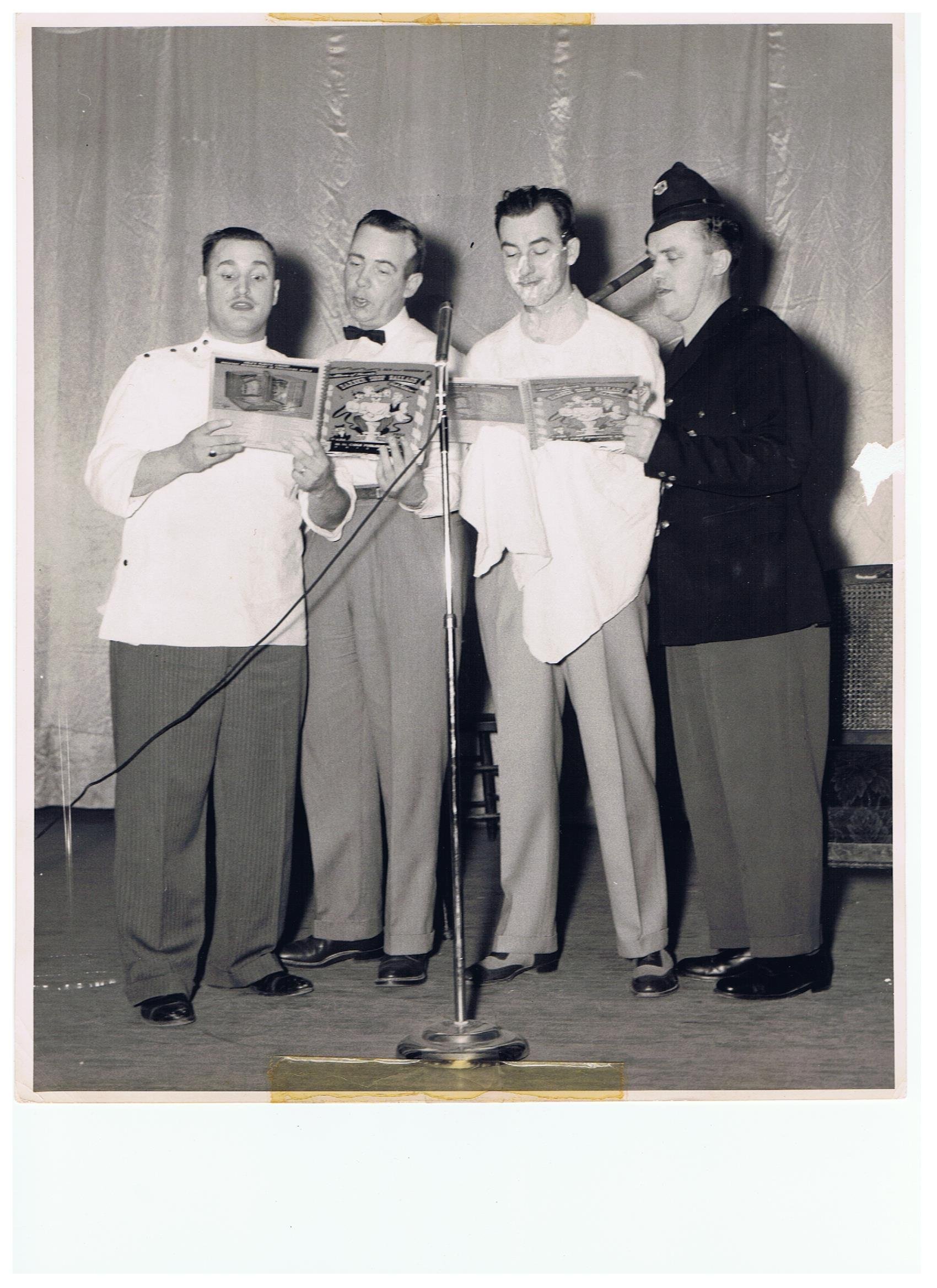
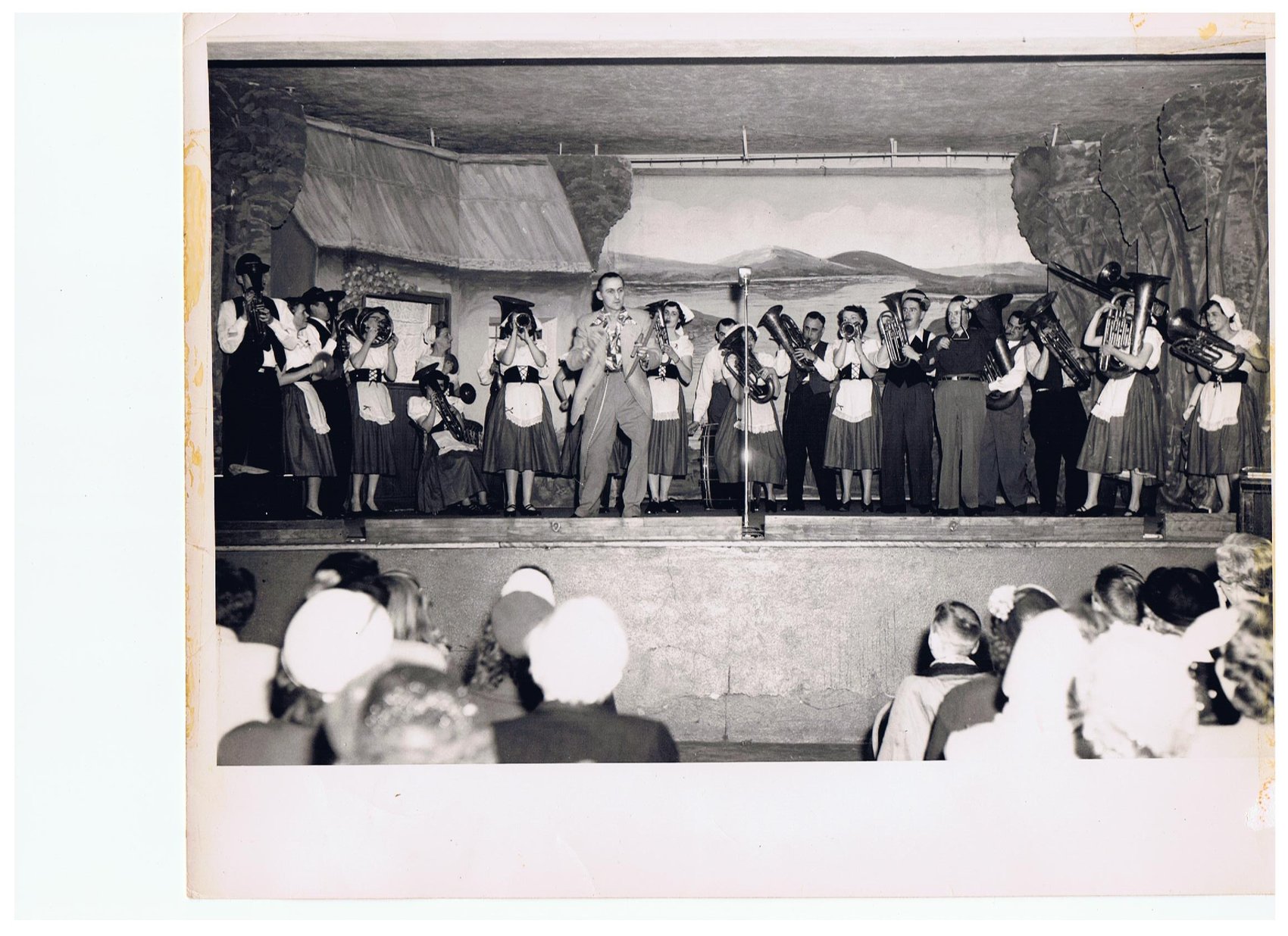


Text of the newspaper clipping:
Pictured above are experts in the dance department going over a few fine points with Choreographer Bernice Marvin and Director Harold Morrow of the YAG REVUE of ‘59, which will be held Thursday and Friday, April 2nd and 3rd at 8:15p.m. in the Verdun United Church Hall, 650 Woodland Ave., Verdun. From left to right are Marilyn Knight, Don Peddar, Dorothy Johnston, Ed Chaffey, Miss Marvin and Mr. Morrow.The Revue plans a departure in programme this year: In addition to the usual variety numbers, a half-hour comedy entitled “Why I am a Bachelor” by Conrad Seiler will be presented depicting, in a lighter vein, the proverbial contrast between the days of the Belle and the Beau and those of the Husband and Wife.
“Gai Paree”, the musical highlight of this year’s show, has a realistic French atmosphere created by material generously contributed by the Tourism and Cultural Attache of the French Government Consulate in Montreal, who will be in attendance, with party, the opening night.
The YAG Revue will run for two days — April 2nd and 3rd — before travelling. Any Service Club or Charitable organization wishing to have the show, or any individual wanting tickets, should contact Mr. Harvey Mercer, P.O. 7-6425.
Facing Our History
Over the years that I’ve been putting out this newsletter, I’ve shared a lot of images and written quite a lot about the “old days” in Verdun. Just over two years ago I put together an exhibit to mark 120 years of our United Church presence here. It traced SouthWest United’s roots in Crawford Park United, formed in the 1940s, and Verdun United, which began as Verdun Methodist Church in 1899.
I loved learning about the individuals who built these churches, often with their own sweat. I love that there were cub packs, CGIT, young people’s bands and choirs, men’s groups and women’s societies … literally some group meeting in the church every day of the week back then. Seemingly, something for everyone. I felt proud of how church folk banded together in times of crisis – the Depression, two World Wars – to support each other and the wider community.
While digging through old pictures and documents, I came across one thing that didn’t make me proud: Blackface.
In the early decades of the 20th century, church cabarets and revues were not only fun for the whole family, they were good fundraisers. Unfortunately, in retrospect those events may not have been as inclusive as the participants thought. Well into the 1950s and even the 60s, many churches, including our two founding congregations, featured minstrel shows (white performers in stylized black makeup) as part of the entertainment.
I have to admit, when I stumbled across evidence of blackface in our church’s history, my first instinct was to sweep it under the rug. After all, this 120th anniversary was meant to be a celebration. Wouldn’t including references to blackface seem like condoning it? But leaving them out didn’t feel like the right thing to do either.
In February 2020, I attended a talk by Prof. Dorothy Williams about the history of blackface in Quebec. Dr. Williams is a respected academic and her research into the topic was a response to the persistent attitude that “we do not have that history here.”
I learned that minstrel shows had existed in the U.S. since the 1840s, but they really gathered steam after slavery was abolished. The stock characters of minstrelsy were created to send a message that people of African descent were stupid and lazy. Minstrel shows even suggested that Southern Blacks had been happier as slaves. All of this was a reaction to the fact that barely a decade after Emancipation, Black people had established universities and were demonstrating that they could compete with Whites in any arena.
There’s no question that blackface and minstrelsy were born in the U.S., but like everything from Model T’s to McDonald’s, they were successfully exported over the border. One thing that Dr. Williams’ presentation made very clear was that in the early decades of the 20th century, these shows were everywhere in North America. You’d have had to be living under a rock not to be aware of them. Minstrel shows were performed in English and in French in Quebec, in big cities and small towns.
Professional minstrelsy had petered out by the 1950s, but it lived on in amateur nights. The school, community and church groups that included blackface numbers in their shows probably thought of them as nostalgic. I’m sure they never intended any harm, but the perpetuation of stereotypes was harmful and continues to be today.
Ultimately, my 120th anniversary exhibit did not contain any references to blackface or minstrelsy. I didn’t feel able to adequately address it within that context.
My reasons for bringing this up now are partly selfish: after carrying it around for two years I need to get it off my chest. I also think it’s important to talk about the less admirable parts of our history, not to make us feel guilty, but to make sure we keep trying to do better. Lots of things that are acceptable in one time and place are recognized down the road as unacceptable.
As a white person I can’t pretend to know what it was like to be one of a small number of non-white people in our pews 60 years ago. I don’t pretend to know what it’s like now. As the United Church, we proudly assert that “all are welcome,” but I wonder how welcome a Black family would have felt sitting in pews on a Sunday morning and hearing an announcement about next Saturday’s minstrel show in the church hall…
I’m not writing this to single out our church or our community as racist. We weren’t any more or less racist than any other community across the country at the time. But that doesn’t make it okay.
I am writing this in hopes of starting a conversation. I think that conversation has to include asking ourselves, as a majority-white congregation: how are we unintentionally discriminating against and excluding people today?
We must not just say “all are welcome” we must live it. That means calling out friends or members of your congregation when they use offensive language. And it means listening with an open heart and not getting defensive when people of colour talk about their experiences.
We have come a long way as United Church, in our attitudes toward Indigenous peoples, the LGBTQ+ community, People of Colour, even women! There’s no point beating ourselves up for past transgressions, as long as we keep trying to do better. Rooting out our own prejudices may be a life-long effort, but it’s time well spent.
- Amy
Learn more about the history of Blackface in Quebec
Prof. Dorothy Williams was recently profiled as a Black Changemaker in Quebec:
Violet Grant States, Jan. 7, 1923 - Jan. 4, 2022
A Verduner born and raised, Violet Grant States was a trailblazer who led a life of service despite the racism of the time. Violet studied piano as a child and hoped to become a music teacher, winning admittance to McGill's Macdonald College.
Her path was blocked by the college dean who asserted that parents would not allow their children to study under a woman of colour. She withdrew from the college but soon won a scholarship to the Conservatoire de musique. She graduated and began teaching music!
In 1940, she attended a recital on Mount Royal by the Montreal Women's Symphony Orchestra, under the baton of conductor Ethel Stark. Young Violet was determined to join the orchestra. Curveball, the MWSO already had a pianist. So Violet took up the clarinet.
She joined the orchestra in 1943 at the age of 20. The MWSO was the first professional Canadian ensemble to play Carnegie Hall and Violet Grant had the distinction of being the first woman of colour to perform in a Canadian symphony. She remained a member until 1965.
That experience was transformative for Violet, giving her confidence to pursue her educational goals. She earned degrees in Arts and Education at a by then more enlightened McGill University in 1968, becoming a public school educator.
Which brings us back to Verdun. Violet taught music in English schools for many years. Remarkably, she also helped Verdun Elementary kids open their first bank accounts, imparting early lessons on saving and money management to hundreds of children.
Though she attended Union United Church, was married there to Roy States in 1958 and played organ and led the church choir for several years, Violet became a Bahá'i in 1961 and remained an active member of that faith community.
Violet Grant States was named a Grande Verdunoise and a Bâtisseuse de la Cité in 2017, in recognition of her life's work. though she was by then too frail to take part in the event. She died at the beginning of 2022, just a few days shy of her 99th birthday.
She was by all accounts an exceptional woman, one not discouraged by those who said "No." She touched thousands, whether by teaching music, leading choir, helping kids save their pennies or by being the lone Black role model in a classroom or orchestra seat.
I hope that one day Montreal honours her by naming a street after this Grande Verdunoise and Bâtisseuse de le Cité, Violet Grant States.
- Mary Lamey



Epilogue:
In the fall of 2019, a digital exhibit celebrating the historic Montreal Women’s Symphony Orchestra was installed in a public space at Place des Arts. Mrs. States, in a wheelchair, was able to visit and see the projected images of herself and the other orchestra members while hearing some of the pieces they played back in the 40s.
The story of the orchestra is told in a 2015 book titled From Kitchen to Carnegie Hall, by Maria Noriega Rashwal.
Memory Lane
Our friend Rohinton Ghandhi continues his labour of love digitizing old newspapers and other documents from the “good old days” in Verdun. He recently shared this one on social media and I thought it might bring back memories. Mrs. Jan Barr, who recently passed away, had a column of social notes in the Verdun Guardian for a time. Ro shared this column from January 1950.
The clipping further down, also from Ro, is from 1938 and reveals the origins of some street names, including Clemenceau and Ouimet.
As for Tetrault Hall, it was on Churchill at the corner of Foch. It's now a multi-apartment building. Before that it was a Douglas hospital community center. Prior to that, it was the Tetrault Hall built by me Tetrault's construction company, and first used in Crawford as a Buffalo/ Elks lodge and a community hall. Mr Tetrault built many commercial buildings in Verdun and LaSalle, including the old LaSalle theatre in the Bronx on Centrale and 5th avenue, destroyed only a few years ago. He was also involved in the construction of and Crawford Park United Church.
When the Monument was on Mullarkey
Earlier this month, when Pastor Beryl participated in Verdun Legion #4’s Remembrance Day, I was reminded of something I learned recently: the Cenotaph (statue in memory of the fallen in the two World Wars and the Korean War) did not always stand outside the Borough Hall at 1st Avenue.
It originally went up in 1924 in honour of the 1914-1918 war dead from Verdun, at the corner of Wellington Street and Mullarkey Avenue.
Where, you ask? It turns out the easternmost end of Lasalle Boulevard used to be called Mullarkey (see map). There’s still a triangular green space there, known as Parc Grenier. Wellington angles off to the right towards the Canadian Tire, Maxi and Point-St-Charles, and Lasalle Boulevard runs along the left side towards Atwater. That section of Lasalle starting at the park used to be called Mullarkey.
Apparently the name was changed around 1930, though I don’t know why. I also don’t know for sure who “Mullarkey” was that he got a street named after him, but it may well have been John. P. Mullarkey who was a railroad contractor in Montreal in the early years of the 20th Century.
The following information is from a website called waymarking.com
“This memorial was constructed by Coeur de Lion MacCarthy for the city of Verdun and is dedicated to the local war dead of the First and Second World Wars and the Korean War. It was unveiled on 5 October 1924 by Jane Leavitt, a Verdun mother who lost three of her five sons in the First World War. This monument originally stood in a park at the corner of Wellington Street and Mullarkey Avenue (now LaSalle Boulevard) but was moved in front of the city hall in 1959. The Verdun Victory Memorial, designed and executed by McCarthy, artist-sculptor of Montreal, depicts a Canadian solder in an exultant attitude, his shrapnel helmet in hand and his rifle raised in the spirit of Victory. At the base of the monument is a female figure, symbolic of patriotism and peace, holding in her right hand the flags of Victory and supporting with her left hand a shield bearing the arms of the City of Verdun.”
Slideshow: Click on image to move to the next one. Pictures of Remembrance Day Ceremony (Nov. 7, 2021) are from the Verdun Legion #4 Facebook page.






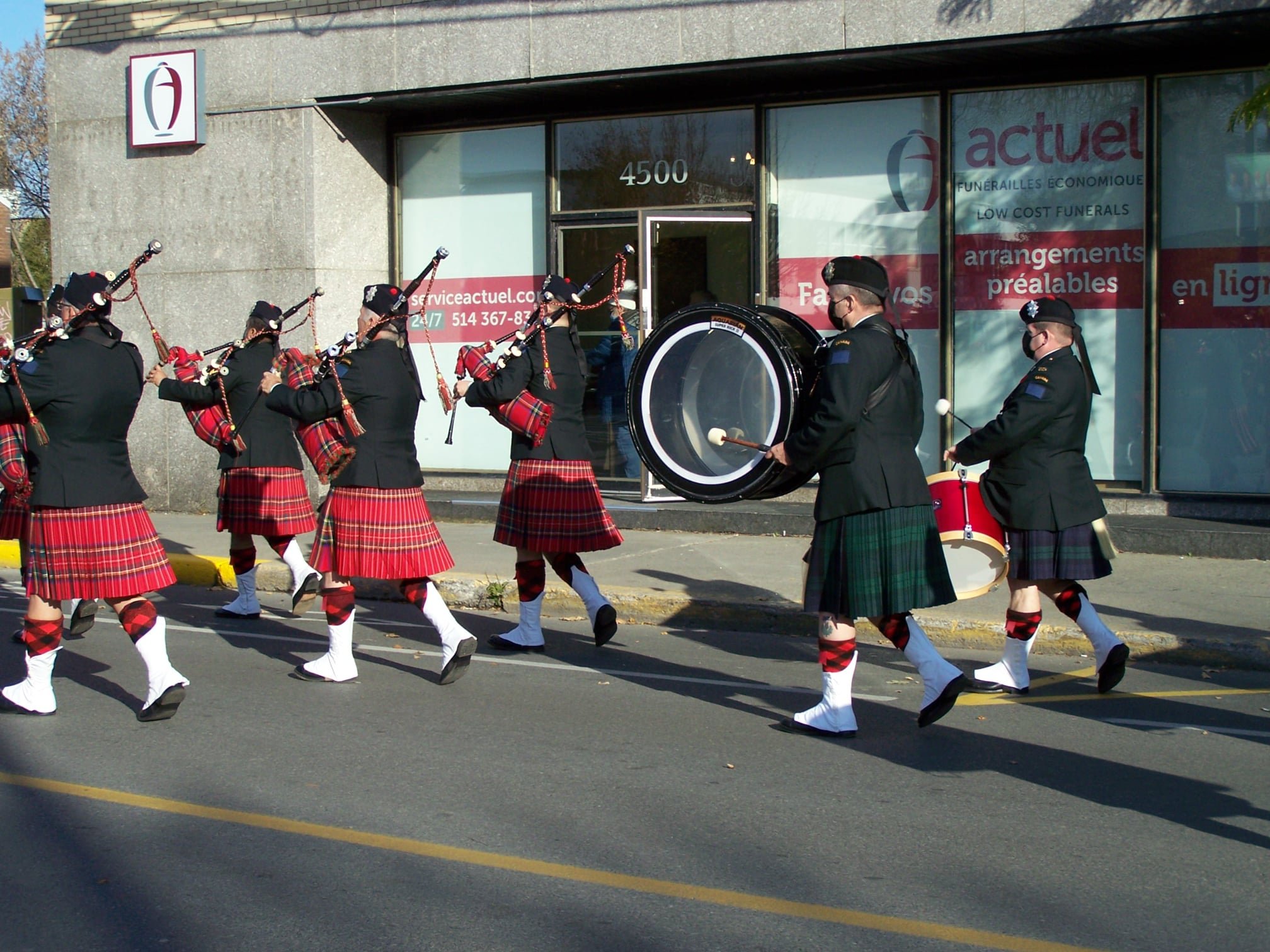




A Creepy Claim to Fame
If you had been walking along Verdun Avenue on July 23rd, 1938, you might have stopped, like the people in this photograph, to watch a coffin being carried out of Wilson’s funeral home and placed in a hearse.
How many of the bystanders knew, I wonder, that the body in the coffin was that of Arthur Ellis, who for over two decades was Canada’s official executioner, or “hangman”?
Born in England in 1864, Arthur Bartholomew Alexander English seems to have apprenticed under John Ellis, England’s Chief Executioner, and taken his last name as a tribute, as well as a handy alias, when he began his career in Canada.
Arthur Ellis was based in Montreal throughout most of his career, but travelled across the country in his, ahem, professional capacity. It’s unknown whether he was living in or near Verdun when he died, but if arrangements were entrusted to Wilson’s, it suggests he was. Newspaper articles from the period claim that he died in extreme poverty, having lost his position due to a “botched” execution. I think that’s as far as I’ll go into the gory details.
What if instead we look around us on that July day in Verdun in 1938? We can’t see the funeral home itself unfortunately, but certainly the facade would have been much different than it is today. The Wilson family sold to Alfred Dallaire in 1989, and Yves Légaré took it over in 2003, but a ‘salon funéraire’ has stood at 5784 Verdun avenue, corner Manning, all this time.
5784 Verdun (southeast corner where it crosses Manning ave.) in 2021.
Kitty-corner from the funeral home, at 5811, we can see Verdun’s own Steinberg’s grocery store, which had opened earlier that year. The family chain of stores was started in 1917, but this was the first Steinberg’s in Verdun, if not the last. Indeed they were so successful that by 1941, the grocery was in need of more space and moved to 5100 Verdun Ave, at the corner of 6th. Yep, that’s where pharmacy Jean Coutu is now.
The former Steinberg’s grocery building at 5811 Verdun ave. has changed a lot. And look how much wider the street is now compared to 1938!
Meanwhile, 5811 Verdun avenue has had many incarnations over the years, including its time as Smith-Main’s bakery in the 1960s. The building suffered a bad fire in 2019 but has been repaired. The ground floor is now occupied by Depanneur Guorong, also known as Mini-Marché Manning.
Post Script
Arthur Ellis was Canada’s hangman for a long time, but he was not our last. Capital punishment continued until it was abolished in 1976, and hanging was always the Canadian method of choice.
Legend has it that Ellis is buried in Mount Royal Cemetery.
Boardwalk Days
I confess to belonging to a number of Facebook groups that specialize in Montreal - and sometimes specifically Verdun - nostalgia. I am a newcomer to Verdun (14 years and counting) so in my case I guess it’s not really nostalgia, but the black-and-white photos on these sites allow me to see a Verdun I have heard about but never seen. I hope you will enjoy this small blast from the past.
Those with long memories will recognize the Band Shell that stood on the Boardwalk in the 40s and 50s, where you could go hear concerts on warm summer nights. In the second shot, you catch a glimpse behind it of the Dance Pavilion (the “Pav”).
This would be Lasalle Boulevard near the bottom of Woodland Avenue. It’s before the waterfront was built up in the 60s: the river is much closer to the road than it is today!
I spent some time during the recent heat wave cooling off at the Natatorium. What a treat to stumble across these pictures from its early days!
This is the “before” shot: breaking ground for the Natatorium in 1938.
A swimming competition in the early 40s. “The Nat” hasn’t changed much over the years except the diving boards are no longer there.
Verdun Then and Now, 2
As a follow-up to last week, here is another picture of Wellington street back in the day, accompanied by my attempt to capture the same view today.
Last week’s Wellington view was facing in the same direction as this, but from further along. Here you can still see the spire of Notre-Dame-des-Sept-Douleurs in the distance but the photographer is standing back at 1st Avenue.
Notice the awnings in front of all the businesses? Back before air conditioning this was how you kept the sun out and the air cooler indoors. On the other hand, as someone pointed out on the site where I found these old photos, there are more trees on Wellington now than back in the day!
Speaking of then and now, restoration and expansion of the Verdun Auditorium has been completed. The siding in the top picture was removed and the original brick facade restored, with bright modern extensions added at side and back.




















